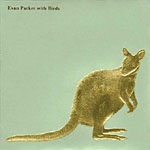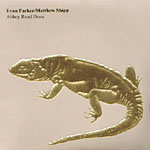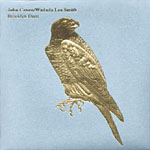Home » Jazz Articles » Record Label Profile » Treader
Treader
We needed our own label to avoid the inevitable justification for ideas that results from somebody other than yourselves paying for them to be recorded.
—John Coxon
Over the next three years, Spring Heel Jack released three more albums on Thirsty Ear, working with Matthew Shipp, Tim Berne, Roy Campbell, Evan Parker, Han Bennink, Paul Rutherford, John Edwards, Wadada Leo Smith and others, producing some of the most exciting music released during those years, culminating in the tranced-out The Sweetness of the Water. By that point, John Coxon and Ashley Wales had carved out a space uniquely their own in the improv world.
 Even after the surprises of the previous years, Spring Heel Jack's next turn was even less predictable. In 2004, a trio of records was released: simple, pastel cardboard covers, their elegant designs featuring gold embossed animals and a title, no other information visible from the outside, one not even including an artist's name. Evan Parker with Birds (a wallaby on green), Trio with Interludes (walrus on blue), Mark Sanders Swallow Chase (a muskrat maybe? on rose). None bore the Spring Heel Jack imprint—Coxon and Wales's new trade name, it seemed, was "Treader."
Even after the surprises of the previous years, Spring Heel Jack's next turn was even less predictable. In 2004, a trio of records was released: simple, pastel cardboard covers, their elegant designs featuring gold embossed animals and a title, no other information visible from the outside, one not even including an artist's name. Evan Parker with Birds (a wallaby on green), Trio with Interludes (walrus on blue), Mark Sanders Swallow Chase (a muskrat maybe? on rose). None bore the Spring Heel Jack imprint—Coxon and Wales's new trade name, it seemed, was "Treader." "We needed our own label to avoid the inevitable justification for ideas that results from somebody other than yourselves paying for them to be recorded," Coxon said in an email interview. "Also, Treader enables us to have a local outlet—we sell the CDs at concerts, and to have the stock in the cellar is a good thing."
The records were an extension of the Spring Heel Jack ideal, but still something quite new. Birds set Parker's saxophones against a collage of bird sounds assembled by Coxon and Wales. Interludes was a quartet, actually, featuring Parker again with Coxon and Wales on an assortment of keyboards, percussion and guitar and Sanders on percussion. The third of the first round was Sanders solo.
If anything characterizes the new direction they took, it's the attention paid to engineering and crafting the sound of the recordings. Where the Thirsty Ear discs were lush band projects, Treader—with nine releases to date—has a close, internalized sound. Coxon and Wadada Leo Smith's Brooklyn Duos, for example, explodes the moment "play" is pressed with the sound of a harmonica under a microscope.
"We want them to sound physical and tangible," Coxon said. "Swallow Chase was mixed from the drum stool perspective - it ought to sound as if the listener is playing the drums. The harmonica sound on Brooklyn Duos has to do with amp distortion. On Abbey Road Duos [this year's third release, a duo with Parker and Matthew Shipp], the big piano sound results from very good mikes and very good mike amps. We try to take the recording out of the digital domain at the end, [to keep it from] sounding too clinical."
The pair's Amplified Trio with drummer Han Bennink, also from this year, sounds like the three are stacked on top of each other with a microphone in the middle. It's a great sonic mash, reminiscent of the mayhem of some of Bennink's early, solo records.
"The Bennink recording is fairly full on I suppose because we were in a small bright loud room—close to each other," Coxon said. "Ashley was feeling really sick. We drank wine and played without talking about it.
"Birds was more circumspect. We prepared the environments over a couple of days and then gave them to Evan. We both made notes and discussed what we had in mind. Evan wanted to do the overdubs on track two, which we hadn't thought about, for example. For Brooklyn Duos, we played for an hour and most is on the CD, but not in order. We had discussed doing a harmonica record for about a year before. It grew out of track one on The Sweetness of the Water, but it turned out a lot less mellow.."
Clearly big music fans, Coxon and Wales take inspiration from many places for their innovative recordings.
"As far as sonic references," Coxon said, "Incus 1 [Topography of the Lungs by Parker, Derek Bailey and Tony Oxley] mid '60s Impulse, Brunswick soul, Deutche Gramophon, Congo Natty Jungle sides, Harry Mudie, Lee Perry... you know the perfect mix of fidelity and distortion."
 But that mix of focused recording and disparate sounds doesn't dictate all of the Treader releases. The third release of 2007, Abbey Road Duos, is a straight-up acoustic duo by Parker and Matthew Shipp.
But that mix of focused recording and disparate sounds doesn't dictate all of the Treader releases. The third release of 2007, Abbey Road Duos, is a straight-up acoustic duo by Parker and Matthew Shipp. "Abbey Road has more of a classic jazz sound," he said. "Perhaps Brooklyn Duos and Amp Trio have a 'Treader' sound because we have no jazz background at all."
Abbey Road is Parker's third appearance on Treader making him one of the most regular guests in the Coxon / Wales enterprise.
"We saw Evan last night, playing his second gig of the evening with guitarist John Russell. It reminded me of what a pivotal role he has played in our (and many others') musical lives. His extraordinary generosity in spirit and practice has enlightened our work ever since we asked him to play on Masses," Coxon said. "And of course his earlier work has been a huge inspiration. Records like Topography of the Lungs', Monoceros, Live at the Unity Theatre, 50th Birthday Concert... He is one of the few musicians who transcends any category. He has a fierce intelligence, a musical elegance undimmed by his unparalleled technique."
Birds has gone on to see concert incarnations and, according to Parker, may be expanded in the future.
"The specific work on Birds began as a studio project but since then we have performed using the same approach live twice in London," Parker said. "I hope we can do an even grander version.
"It seems like only yesterday that John and Ashley were first in touch, but I think it may be eight years now since we first started to collaborate," he added. "They work very well together while remaining very different individuals—this is probably their secret. They also work very hard. Their presence in London is a great blessing to the general scene; they are forever thinking up new ideas for concerts and recordings and finding ways to make them happen."
 Treader may be the primary outlet in the duo's enterprise, but it's not the only one. Until recently they had a show on the London Musician Collective's Resonance Radio, which allowed them to test run new recordings. The Bennink record, for example, was played on the air the day it was recorded. They also host an ongoing concert series in London.
Treader may be the primary outlet in the duo's enterprise, but it's not the only one. Until recently they had a show on the London Musician Collective's Resonance Radio, which allowed them to test run new recordings. The Bennink record, for example, was played on the air the day it was recorded. They also host an ongoing concert series in London. "Ashley curates the 'Back in Your town' concerts at the Red Rose," he said. "We collaborate on concerts involving Treader releases and offset the costs as a recording expense. That allows us to give the door to the artist and keep the tickets really cheap, $10—a good value for the likes of John Tchicai, Han Bennink, Other Dimensions in Music and Sunny Murray. The posters Ashley makes for the concerts are such classics—I would love to see the best of them reproduced somewhere."
The coming year holds more surprises from the fold, including another round of Treader releases and a return to the Spring Heel Jack moniker. A second Shipp album was recorded the same day as the Parker duet, this one with J. Spaceman, the Spaceman 3 and Spiritualized guitarist who's heard on some Spring Heel Jack releases and released a solo disc, Guitar Loops, on Treader in 2005. There's also an Alex Ward solo release in the can, and the pair will return to their all-star big band mode with Songs and Themes, a septet with Tchicai, Roy Campbell and John Edwards, and Spaceman appearing one two tracks.
And no doubt those discs will be another round of well-crafted events. "We are interested in making 'records,'" Coxon said, "not documents."
< Previous
Meandering Road
Comments
Tags
For the Love of Jazz
 All About Jazz has been a pillar of jazz since 1995, championing it as an art form and, more importantly, supporting the musicians who create it. Our enduring commitment has made "AAJ" one of the most culturally important websites of its kind, read by hundreds of thousands of fans, musicians and industry figures every month.
All About Jazz has been a pillar of jazz since 1995, championing it as an art form and, more importantly, supporting the musicians who create it. Our enduring commitment has made "AAJ" one of the most culturally important websites of its kind, read by hundreds of thousands of fans, musicians and industry figures every month.






















